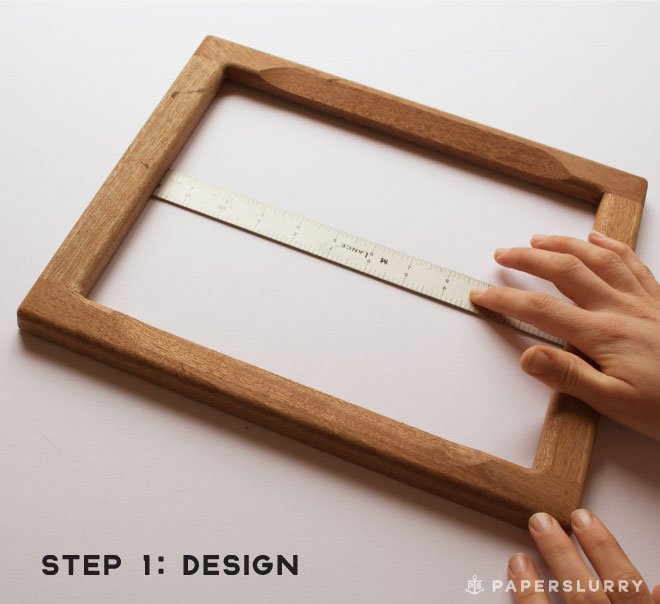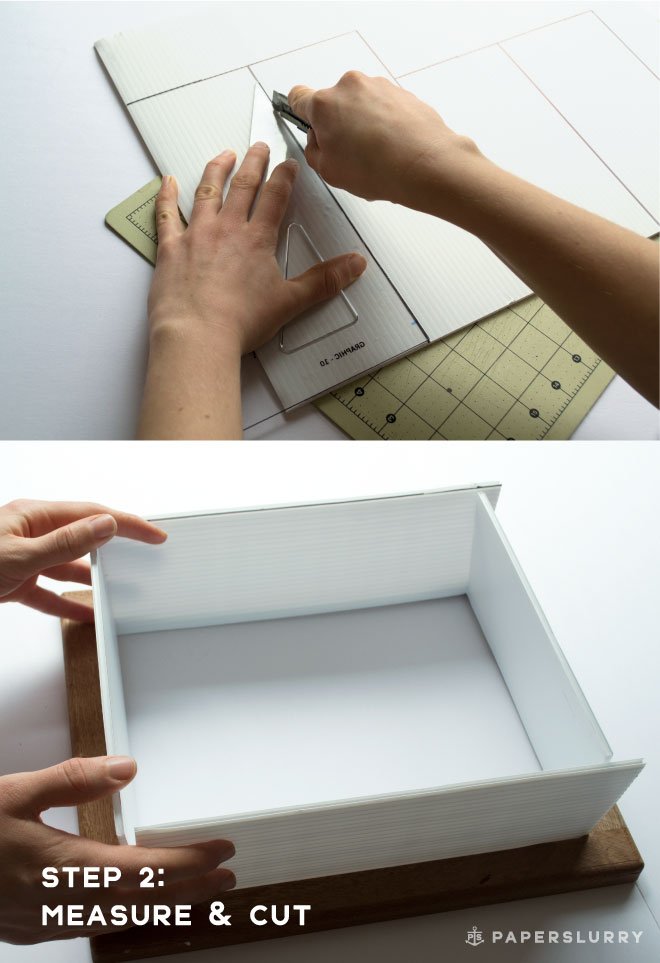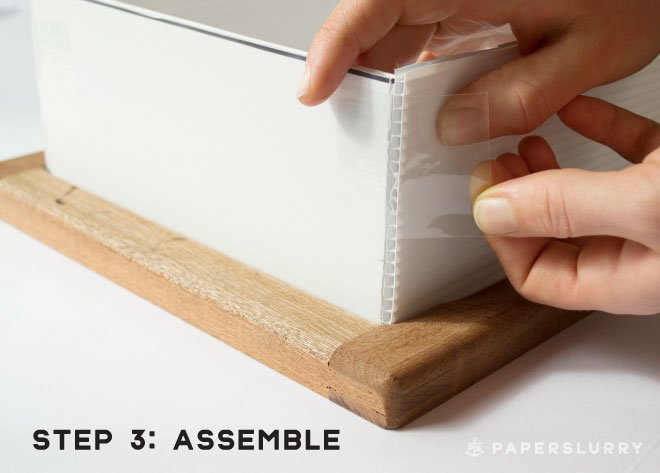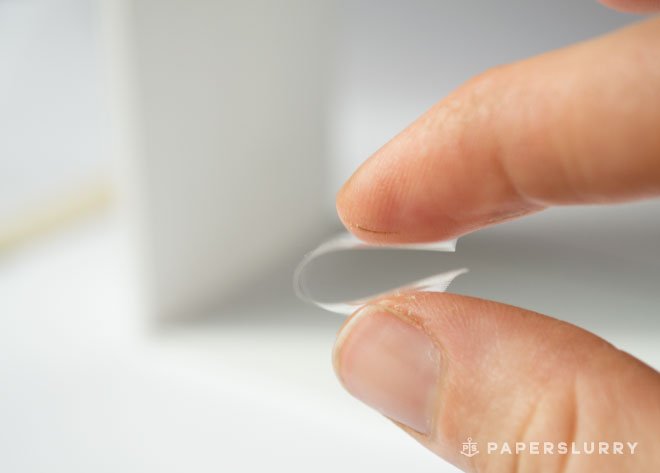How to Make a Deckle Box for Hand Papermaking (Part 1)
Hand papermaking conventionally relies on three elements: vat, fiber, screen (click over to the basic handmade paper tutorial if you’re not familiar with the process).
A deckle box combines the vat and screen elements into a single piece of equipment, and holds enough water and pulp for a single sheet—no vat required! This alternative temporarily builds up the walls of your mould and deckle.
You can make your own deckle box at home using a few materials from the hardware store and your existing mould and deckle. This tutorial shows you how to design and make a basic deckle box, which can be customized to fit any mould or project. (If you’re on the market for a mould and deckle, check out our tutorial to learn how to make one at home.)
Looking for instructions on how to use it? Here are two approaches that use this deckle box to create beautiful sheets of handmade paper!
Unique sheets, inclusions, or even heavy weight paper are just a few creative ways to use a deckle box. They’re also useful for test sheets, or if you only have a small amount of pulp.
SUPPLIES
Corrugated plastic
Heavy duty shipping tape (clear)
Ruler/triangle
Utility knife
Deckle
Bone folder
Optional: self healing cutting mat
STEP 1: Design
The corrugated plastic is used to create the raised walls; it's impervious to water and the corrugation provides internal stability. Find it at the hardware store—it’s often used for signage. Some papermakers also build their own wooden deckle boxes using a similar process. The height of the sidewalls depends on the project, since they essentially determine the volume of the vat. Four inches is a good basic height. If the walls become too high, they are difficult to work with and the weight of the pulp and water may strain the face of the mould.
Break out the #2 pencils, scrap paper, and fill up that coffee mug—we’re going to have to do some calculations. Follow the equation below to measure out the four panels to ensure a snug fit. I promise we won’t be branching off into math tutorials any time soon!
(Inside Deckle Length) − (Thickness of Corrugated Plastic) = Length 1 make two of these
(Inside Deckle Width) − (Thickness of Corrugated Plastic) = Width 1 make two of these
how to make a deckle box for hand paper making
Our dimensions looked like this:11 inches − 0.25 inches = 10.75 inch length pieces8.5 inches − 0.25 inches = 8.25 inch width pieces.
Eliminating that extra thickness will allow the pieces for fit together securely and maintain that nice 90 degree angle we all know and love. By only subtracting .25 inch from each side, the sides can shimmy up beside one another and provide another layer of support.
STEP 2: CUT
Place the self healing mat beneath the corrugated plastic to prevent any marring on the surface below. With the utility knife, cut as straight as possible along the measured lines.Use a triangle or t-square aligned with the factory cut edge as a guide for the blade if you are struggling to establish a clean cut.As with most things in papermaking (or situations involving sharp objects...), slow and steady wins the race. Check the angles using a triangle or T-square and make a mark to indicate the smoothest/straightest edges. These are the edges that will come into contact with the mould. If the panels are not flush on the face of the mould, pulp will seep beneath and collect on the deckle. The deckle box pieces should fit snuggly inside the deckle without buckling or bending. Trim as necessary, shaving off small strips of the plastic until it fits securely.
STEP 3: ASSEMBLE
Apply strips of tape to diagonal exterior joints of the deckle box. The deckle will support the panels as you begin taping them and ensures that the deckle box fits the deckle like a glove; any shifting that occurs remains within the boundaries of the deckle. Think of it like furniture assembly: you tighten all screws incrementally to allow for shifting as needed. Apply a small layer of tape on the interior joints of the deckle box. Continue to tape the exterior joints until all panels are connected.
Check the alignment of the panels continuously to ensure the panels remain level. Keep tape as smooth as possible; wrinkles might affect the fit of the deckle box. Tape until it feels secure and can withstand moderate pressure. The interior joint taping is a bit more arduous because we want the right angle taped as cleanly as possible. This is where the deckled edge will form, so any slopes in the taping will create rounded corners.
Cut twelve even strips of packing tape 3-4 inches long. Rest the longer panel flush on the tabletop with the shorter end perpendicular to the table. Fold in the tape half widthwise with the adhesive side facing up and out. If we’re being precise, this is a “hamburger bun” style fold, we’re all about the technical terms here, folks! The tape is the adhesive hinge to hold the panels in place. Crease along the fold of the tape with a bone folder and rotate as needed to burnish down the rest of the tape. Repeat this process across the joint until the seam is completely sealed.If there is a little wiggle, don’t worry, you can adjust as needed—if it is too rigid, there may be issues when trying to insert/remove it from the deckle. Line the open corrugated edges of plastic with tape as well. While the plastic won’t warp when exposed to water, it’s best to seal off any openings for drying purposes.
Slip it into the deckle and get ready to take it for a spin! Read Part 2 of this tutorial, which shows you two techniques for using your new deckle box.
FURTHER READING:
Need a refresher on how to prepare your fiber? Check out our recycled materials hand papermaking tutorial here.
If you want to design your deckle box to hold a specific volume of fiber, check out this quick video that reviews how to calculate the volume of a box (I guess the math teachers were right, all these equations are applicable in “real life”!)






